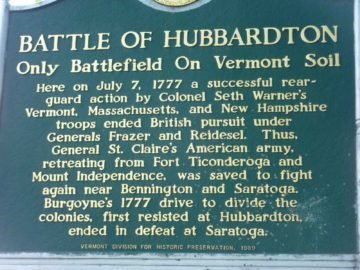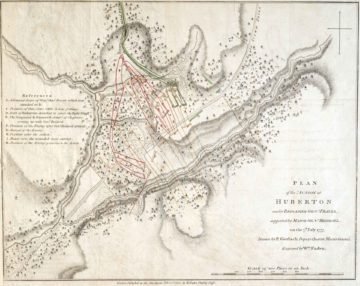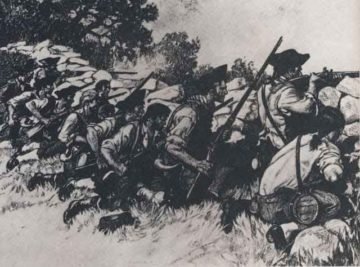The Battle of Hubbardton
July 7, 1777 at Hubbardton, Vermont

Battle Summary
The Battle of Hubbardton was an engagement in the Saratoga Campaign 1777, fought in the village of Hubbardton, Vermont (what is now Walloomsac, New York.). Vermont was then a disputed territory sometimes called the New Hampshire Grants, claimed by New York, New Hampshire, and the newly organized and not yet recognized but de facto independent government of Vermont.
British forces, under Brigadier General Simon Fraser, caught up with the American rear guard of the forces retreating after the withdrawal from Fort Ticonderoga. The Battle of Hubbardton was the only battle in Vermont during the revolution.
The American retreat from Fort Ticonderoga began late on July 5. The bulk of Major General Arthur St. Clair's army retreated through Hubbardton to Castleton, while the rear guard, commanded by Colonel Seth Warner, stopped at Hubbardton to rest and pick up stragglers.
On July 6, after being alerted to the American withdrawal, Frasier immediately set out in pursuit, leaving a message for Lieutenant General John Burgoyne to send reinforcements as quickly as possible. That night Fraser camped a few miles short of Hubbardton, and Major General Friedrich Adolf Riedesel, leading reinforcements, camped a few miles further back.
On July 7, rising early in the morning, Fraser reached Hubbardton, where he surprised some elements of the American rear, while other elements managed to form defensive lines. In spirited battle, the Americans were driven back, but had almost succeeded in turning Fraser's left flank when Riedesel and his German reinforcements arrived, eventually scattering the American forces.
The battle took a large enough toll on the British forces that they did not further pursue the main American army. The American prisoners were sent to Ticonderoga while most of the British troops made their way to Skenesboro to rejoin Burgoyne's army. Most of the scattered American remnants made their way to rejoin St. Clair's army on its way toward the Hudson River.
Facts about the Battle of Hubbardton
- Armies - American Forces was commanded by Col. Seth Warner and consisted of about 730 Soldiers. British Forces was commanded by Gen. Baron Friedrich A. Riedesel and consisted of about 1,030 Soldiers.
- Casualties - American casualties were estimated to be 41 killed, 95 wounded, and 234 missing/captured. British casualties was approximately 60 killed and 138 wounded.
- Outcome - The result of the battle was a tactical British victory but a strategic American victory. The battle was part of the Saratoga Campaign 1777.
Prelude
St. Clair paused at Hubbardton to give the main army's tired and hungry troops time to rest while he hoped the rear guard would arrive. Col. Ebenezer Francis' 11th Massachusetts Regiment acted as St. Clair's rear guard. When it did not arrive in time, he left Colonel Seth Warner and the Green Mountain Boys behind, along with the 2nd New Hampshire Regiment under Colonel Nathan Hale, at Hubbardton to wait for the rear while the main army marched on to Castleton.
When Francis' and Hale's men arrived, Warner decided, against St. Clair's orders, that they would spend the night there, rather than marching on to Castleton. Warner, who had experience in rear-guard actions while serving in the Invasion of Quebec, arranged the camps in a defensive position on Monument Hill, and set patrols to guard the road to Fort Ticonderoga.
Riedesel caught up with Fraser around 4:00 PM, and insisted that his men could not go further before making camp. Fraser, who acquiesced to this as Riedesel was senior to him in the chain of command, pointed out that he was authorized to engage the enemy, and would be leaving his camp at 3:00 AM the next morning. He then advanced until he found a site about three miles from Hubbardton, where his troops camped for the night. Riedesel waited for the bulk of his men, about 1,500 strong, and also made camp.
Battle Begins
Fraser's men were up at 3:00 AM, but did not make good time due to the darkness. Riedesel left his camp at 3:00 AM with a group of men, and was still behind Fraser when the latter arrived at Hubbardton near dawn and very nearly surprised elements of Hale's regiment, which were scattered in the early fighting. A messenger had arrived from St. Clair delivering news that the British had reached Skenesboro, where the elements of the retreating army had planned to regroup, and that a more circuitous route to the Hudson River was now required.
St. Clair's instructions were to follow him immediately to Rutland. Francis' men had formed a column to march out around 7:15 AM when the British vanguard began cresting the hill behind them. Rapidly reforming into a line behind some cover, the Massachusetts men unleashed a withering volley of fire at the winded British.
Fraser took stock of the situation, and decided to send a detachment around to flank the American left, at the risk of exposing his own left, which he hoped would hold until Riedesel arrived. Riedesel reached the top of another hill, where he observed that the American line, now including parts of Hale's regiment, was in fact pressing on Fraser's left. He therefore sent his grenadiers to support Fraser's flank and directed the jägers against the American center.
At some point early in the conflict, St. Clair was made aware of the gunfire off in the distance. He immediately dispatched Henry Brockholst Livingston and Isaac Dunn to send the militia camped closest to Hubbardton down the road in support of the action.
When they reached the area of those camps they found those militia companies in full retreat away from the gunfire in the distance, and no amount of persuasion could convince the men to turn around. Livingston and Dunn continued riding toward Hubbardton.
Falling back to a secure position on Monument Hill, the Americans repulsed several vigorous British assaults, although Francis was hit in the arm by a shot. He soldiered on, directing troops to a perceived weakness on Fraser's left.
The tide of the battle turned when, after more than an hour of battle, Riedesel's grenadiers arrived. These disciplined forces entered the fight singing hymns to the accompaniment of a military band to make them appear more numerous than they actually were. The American flanks were turned, and they were forced to make a desperate race across an open field to avoid being enveloped. Francis fell in a volley of musket fire as the troops raced away from the advancing British and scattered into the countryside
Aftermath
The scattered remnants of the American rear laboriously made their way toward Rutland in order to rejoin the main army. Harassed by Fraser's scouts and Indians, and without food or shelter, it took some of them five days to reach the army, which was by then nearing Fort Edward.
Others, including Hale and a detachment of 70 men, were captured by the British as they mopped up the scene. Francis, in a sign of respect from his opponents, was buried with the Brunswick dead.
Riedesel and the Brunswickers departed for Skenesboro the next day, much to Fraser's chagrin. Their departure left him in "the most disaffected part of America, every person a Spy", with 600 tired men, a sizable contingent of prisoners and wounded, and no significant supplies.
On July 9, Riedesel sent the 300 American prisoners, under light guard but with threats of retaliation should they try to escape, toward Fort Ticonderoga while he marched his exhausted forces toward Castleton and then Skenesboro.
The Battle of Hubbardton is regarded as an important American tactical victory because sufficient time was secured to allow St. Clair’s main force to proceed to safety in Castleton, less than ten miles to the south. Unlike earlier battles, the Continental Army troops continued to fight in a disciplined manner despite suffering heavy losses.
Once they had achieved their aim, the Americans executed a dangerous but successful disengagement from the enemy and retreated to join St. Clair. The British losses at Hubbardton were sufficient to end thoughts of further pursuit. The force returned to Fort Ticonderoga and linked up with Burgoyne’s main army.



